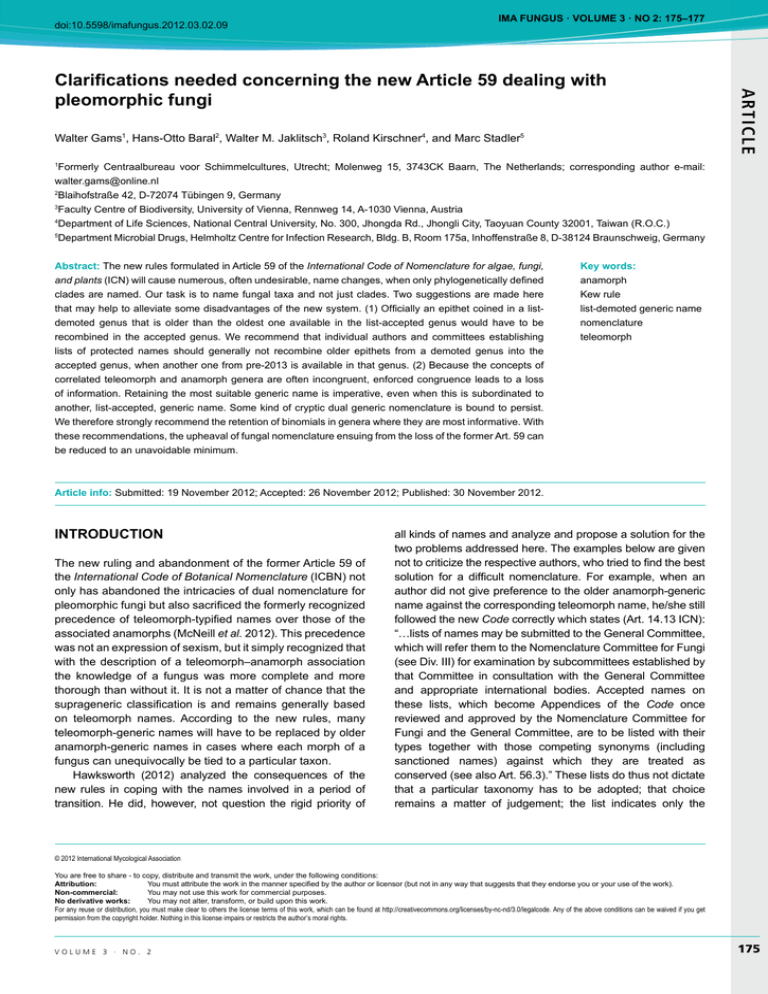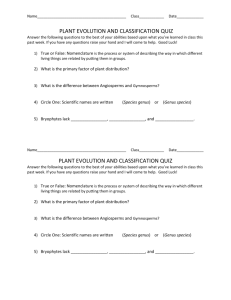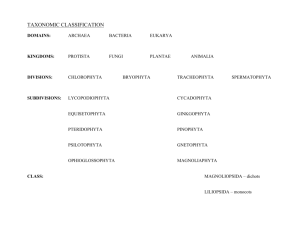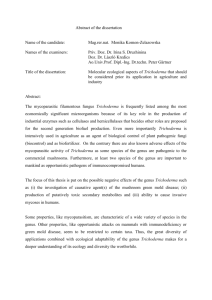AR TICLE Clarifications needed concerning the new Article 59
advertisement

doi:10.5598/imafungus.2012.03.02.09 IMA Fungus · volume 3 · no 2: 175–177 Walter Gams1, Hans-Otto Baral2, Walter M. Jaklitsch3, Roland Kirschner4, and Marc Stadler5 ART I CLE Clarifications needed concerning the new Article 59 dealing with pleomorphic fungi Formerly Centraalbureau voor Schimmelcultures, Utrecht; Molenweg 15, 3743CK Baarn, The Netherlands; corresponding author e-mail: walter.gams@online.nl 2 Blaihofstraße 42, D-72074 Tübingen 9, Germany 3 Faculty Centre of Biodiversity, University of Vienna, Rennweg 14, A-1030 Vienna, Austria 4 Department of Life Sciences, National Central University, No. 300, Jhongda Rd., Jhongli City, Taoyuan County 32001, Taiwan (R.O.C.) 5 Department Microbial Drugs, Helmholtz Centre for Infection Research, Bldg. B, Room 175a, Inhoffenstraße 8, D-38124 Braunschweig, Germany 1 Abstract: The new rules formulated in Article 59 of the International Code of Nomenclature for algae, fungi, and plants (ICN) will cause numerous, often undesirable, name changes, when only phylogenetically defined clades are named. Our task is to name fungal taxa and not just clades. Two suggestions are made here that may help to alleviate some disadvantages of the new system. (1) Officially an epithet coined in a listdemoted genus that is older than the oldest one available in the list-accepted genus would have to be recombined in the accepted genus. We recommend that individual authors and committees establishing lists of protected names should generally not recombine older epithets from a demoted genus into the accepted genus, when another one from pre-2013 is available in that genus. (2) Because the concepts of correlated teleomorph and anamorph genera are often incongruent, enforced congruence leads to a loss of information. Retaining the most suitable generic name is imperative, even when this is subordinated to another, list-accepted, generic name. Some kind of cryptic dual generic nomenclature is bound to persist. We therefore strongly recommend the retention of binomials in genera where they are most informative. With these recommendations, the upheaval of fungal nomenclature ensuing from the loss of the former Art. 59 can be reduced to an unavoidable minimum. Key words: anamorph Kew rule list-demoted generic name nomenclature teleomorph Article info: Submitted: 19 November 2012; Accepted: 26 November 2012; Published: 30 November 2012. INTRODUCTION The new ruling and abandonment of the former Article 59 of the International Code of Botanical Nomenclature (ICBN) not only has abandoned the intricacies of dual nomenclature for pleomorphic fungi but also sacrificed the formerly recognized precedence of teleomorph-typified names over those of the associated anamorphs (McNeill et al. 2012). This precedence was not an expression of sexism, but it simply recognized that with the description of a teleomorph–anamorph association the knowledge of a fungus was more complete and more thorough than without it. It is not a matter of chance that the suprageneric classification is and remains generally based on teleomorph names. According to the new rules, many teleomorph-generic names will have to be replaced by older anamorph-generic names in cases where each morph of a fungus can unequivocally be tied to a particular taxon. Hawksworth (2012) analyzed the consequences of the new rules in coping with the names involved in a period of transition. He did, however, not question the rigid priority of all kinds of names and analyze and propose a solution for the two problems addressed here. The examples below are given not to criticize the respective authors, who tried to find the best solution for a difficult nomenclature. For example, when an author did not give preference to the older anamorph-generic name against the corresponding teleomorph name, he/she still followed the new Code correctly which states (Art. 14.13 ICN): “…lists of names may be submitted to the General Committee, which will refer them to the Nomenclature Committee for Fungi (see Div. III) for examination by subcommittees established by that Committee in consultation with the General Committee and appropriate international bodies. Accepted names on these lists, which become Appendices of the Code once reviewed and approved by the Nomenclature Committee for Fungi and the General Committee, are to be listed with their types together with those competing synonyms (including sanctioned names) against which they are treated as conserved (see also Art. 56.3).” These lists do thus not dictate that a particular taxonomy has to be adopted; that choice remains a matter of judgement; the list indicates only the © 2012 International Mycological Association You are free to share - to copy, distribute and transmit the work, under the following conditions: Attribution: You must attribute the work in the manner specified by the author or licensor (but not in any way that suggests that they endorse you or your use of the work). Non-commercial: You may not use this work for commercial purposes. No derivative works: You may not alter, transform, or build upon this work. For any reuse or distribution, you must make clear to others the license terms of this work, which can be found at http://creativecommons.org/licenses/by-nc-nd/3.0/legalcode. Any of the above conditions can be waived if you get permission from the copyright holder. Nothing in this license impairs or restricts the author’s moral rights. volume 3 · no. 2 175 ART I CLE Gams et al. choice of names in whatever taxonomy an author wishes to adopt. We maintain that it is important that the list entries not be made before a careful analysis and a decision taken by the competent committees. We are aware that difficulties may have arisen from misleading formulations in the Code and thus indicate the need for clarification. Gams et al. (2012) pointed out the desirability of calling the preferred/listed names “prioritized” to distinguish the situation from that of conservation. The opposite would have been a “suppressed” name (which in certain situations can still be used). This terminology is not sufficiently clear and may cause misunderstandings. Therefore we speak now of list-accepted and list-demoted names, in order to distinguish the situation from that of conservation/rejection. CLARIFICATIONS REQUIRED I. The new rules would imply that an older epithet coined in a list-demoted genus has to be recombined in the list-accepted genus This would entail a very high number of undesirable name changes in some genera. Examples (1) If the genus name Trichoderma 1794 is listed with preference over Hypocrea 1825, the older epithet of Hypocrea schweinitzii (Fr. 1828) Sacc. 1883 would have to be recombined in Trichoderma, displacing the established name Trichoderma citrinoviride Bissett 1984. This is fortunately not done by Samuels et al. (2012). Conversely, according to this suggestion, the now established name Hypocrea citrina (Overton et al. 2006) would have to be called Trichoderma lacteum Bissett 1992, a so far hardly used name that may also not be desirable, because Hypocrea lactea is now regarded as a synonym of H. citrina. Thus a critical judgement is required when establishing a list of accepted names. (2) Hirooka et al. (2011), in a paper written just before the new rules were set, retained Nectria canadensis Ellis & Everh. 1884, although the anamorph name Tubercularia grayana (Sacc. & Ellis 1882) Seifert 1985 is older. Similarly: Nectria pseudotrichia Berk. & M.A. Curtis 1853 is predated by the anamorph Tubercularia lateritia (Berk. 1843) Seifert 1985 but not replaced nomenclaturally. Note that the generic name Nectria (Fr. 1825) Fr. 1849 also is younger than Tubercularia Tode 1790, but obviously deserves preference. (3) Orbilia brochopaga (Drechsler 1937) comb. nov. would have to be introduced to replace Orbilia orientalis (Raitv. 1991) Baral 1999, simply because of the available older anamorph epithet of Drechslerella brochopaga (Drechsler 1937) M. Scholler et al. 1999. More about this question below. Comments The new wording of Art. 59 may be misleading in this respect. Its explicit statement that names introduced before 2013 separately for teleomorphs and associated anamorphs are not automatically each other’s (legitimate or illegitimate) synonyms as they are based on different types permits 176 retention of either name. Braun (2012) rightly emphasized that “names published prior to 1 January 2013 for the same taxon, but based on different morphs, are neither considered to be alternative names according to Art 34.2 nor superfluous names according to Art. 52.1, i.e. they are legitimate (if not illegitimate due to other reasons). Such synonyms are valid names, and valid names remain available for use.” Therefore individual authors and committees establishing lists of protected names should generally not recombine older epithets from a list-demoted genus into the list-accepted genus, when another one from pre2013 is already available in that genus. This is in line with the botanical ‘Kew Rule’, adopted in the first volumes of Index Kewensis but never in the Code, which says: “Under this rule, priority within a genus was reckoned from the date when a specific epithet was first associated with that generic name. Older epithets, previously associated with species placed in other genera, were ignored” (Stevens 1991). II. Presently the concepts of correlated teleomorph and anamorph genera are often incongruent, while both of them are meaningful. Enforcing congruence leads to unnatural and unworkable Procrustean1 beds and loss of information In such cases, retaining the most suitable generic name is imperative, even when this is subordinated to another listaccepted generic name. Many ‘orphan’ species (Hawksworth 2012) remain anyhow, which cannot yet be properly classified. Examples (1) Crous et al. (2009) found Mycosphaerella sensu stricto to phylogenetically coincide with species having anamorphs in Ramularia, and gave preference to binomials in that genus, but the same author (Crous 2009) happily continued to use the generic name Mycosphaerella for the hundreds of species that are not yet phylogenetically reorganized. (2) Scopulariopsis Bainier 1907 is predated by the associated teleomorph-generic name Microascus Zukal 1885, but older than Kernia Nieuwl. 1916, which also has Scopulariopsis anamorphs. Merging these genera into one would be confusing and undesirable. (3) In the monophyletic genus Hypocrea, a name to be subordinated under the older anamorph name Trichoderma, as accepted by a majority of members of the International Subcommission on Trichoderma and Hypocrea (ISTH), certain species lack an anamorph or have anamorphs quite different from Trichoderma. Would it not be the best solution to simply retain these in Hypocrea? (4) In the example of Orbilia, discussed under “I” above, it would be the simplest solution to retain for the species in question the anamorph name Drechslerella brochopaga, because the generic name Drechslerella, like Arthrobotrys Procrustes, in Greek mythology, a son of Poseidon who placed his guests on an iron bed, stretching them or cutting off their legs, so as to force them to fit the size of the bed. 1 ima fUNGUS Clarifications needed in naming pleomorphic fungi (5) Cordyceps militaris (L. 1753) Link 1833 is the oldest and indispensable name of a well-known fungus, in contrast to its still not definitely named and less known Lecanicillium anamorph. It would, however, be totally irresponsible to combine all species of the paraphyletic genus Lecanicillium into Cordyceps. Comment Some kind of cryptic dual generic nomenclature is therefore bound to persist. For binomials of species it will be easier to choose the most plausible unique name. Many systematists seem to forget that our task is to name fungal taxa, and not just clades. We therefore strongly recommend to retain binomials in genera where they are most informative. When following these recommendations, the upheaval of fungal nomenclature ensuing from abandoning the old Art. 59 can be reduced to an unavoidable minimum. References Braun U (2012) The impacts of the discontinuation of dual nomenclature of pleomorphic fungi: the trivial facts, problems, and strategies. IMA Fungus 3: 81–86. Crous PW (2009) Taxonomy and phylogeny of the genus Mycosphaerella and its anamorphs. Fungal Diversity 38: 1–24. Crous PW, Summerell BA, Carnegie AJ, Wingfield MJ, Hunter GC, Burgess TI, Andjic V, Barber PA, Groenewald JZ (2009) Unravelling Mycosphaerella: do you believe in genera? Persoonia 23: 99–118. Gams W, Humber RA, Jaklitsch WM, Kirschner R, Stadler M (2012) Minimizing the chaos following the loss of Article 59: suggestion sfor a discussion. Mycotaxon 119: 495–507. Hawksworth DL (2012) Managing and coping with names of pleomorphic fungi in a period of transition. Mycosphere 1: 143– 155. Doi 10.5943/mycosphere/3/2/4; IMA Fungus 3: 15–24. Hirooka Y, Rossman AY, Samuels GJ, Lechat C, Chaverri P (2012) A monograph of Allantonectria, Nectria and Pleonectria (Nectriaceae, Hypocreales, Ascomycota) and their pycnidial, sporodochial, and synnematous anamorphs. Studies in Mycology 71: 1–210. McNeill J, Barrie FR. Buck WR, Demoulin V, Greuter W, Hawksworth DL, Herendeen PS, Knapp S, Marhold K, Prado J, Prud’homme van Reine WF, Smith GE, Wiersema JH, Turland NJ (eds) (2012) International Code of Nomenclature for algae, fungi, and plants (Melbourne Code) adopted by the Eighteenth International Botanical Congress Melbourne, Australia, July 2011. [Regnum Vegetabile no. 154.] Ruggell: A.R.G. Gantner Verlag. Overton BE, Stewart EL, Geiser DM, Jaklitsch WM (2006) Systematics of Hypocrea citrina and related taxa. Studies in Mycology 56: 1–40. Samuels GJ, Ismaiel A, Mulaw TB, Szakacs G, Druzhinina IS, Kubicek CP, Jaklitsch WM (2012) The Longibrachiatum clade of Trichoderma: a revision with new species. Fungal Diversity 55: 77–108. Scholler M, Hagedorn G, Rubner A (1999) A reevaluation of predatory orbiliaceous fungi. II. A new generic concept. Sydowia 51: 89– 113. Stevens PF (1991) George Bentham and the Kew Rule. In: Improving the Stability of Names: needs and options (Hawksworth DL, ed.): 157–168. [Regnum Vegetabile no. 123.] Königstein: Koeltz Scientific Books. [Also available from the International Plant Names Index website, http://ipni.org/understand_the_data.html.] ART I CLE and other anamorph-generic names for nematode-trapping species, conveys phylogenetic and ecological information that would be lost by merging all species in Orbilia. Unpublished morphological and phylogenetic data on a vast number of species of Orbiliaceae indicate that the nematode-trapping fungi form a comparatively young clade out of many further taxonomic groups that comprise very numerous species. These remaining groups are rather well-defined by teleomorphic features and possess various other, non-nematophagous anamorphs. When treating the nematode-trapping group as three or four different genera, the remaining groups would then need to be handled similarly. The associated anamorphs are only diagnostic for some of these genera in regard to conidial morphology, and trapping organs are unknown in all of them. Hence, a classification according to teleomorph and DNA characteristics may be the preferable option. Classifying the nematode-trappers in the genera Arthrobotrys, Drechslerella, Dactylellina and Gamsylella, as proposed by Scholler et al. (1999), may be the beginning of a generic inflation. Such a procedure could eventually lead to the erection of numerous genera within the large genus Orbilia as presently circumscribed. As a further complication, trapping organs are also known in Lecophagus and Hyalorbilia, two quite basal genera of the Orbiliomycetes with no genetic connection to the nematode-trapping taxa. CONCLUSION At the moment we can only offer guidelines for taxonomic revisions and the work of committees involved in establishing lists of names to be protected. It is hoped that such mechanisms of fine-tuning will eventually also find their way into subsequent editions of the Code. Acknowledgements We are grateful to John McNeill for making parts of the new Code available before its publication, and to him and David L. Hawksworth for constructive comments on the present text. volume 3 · no. 2 177




